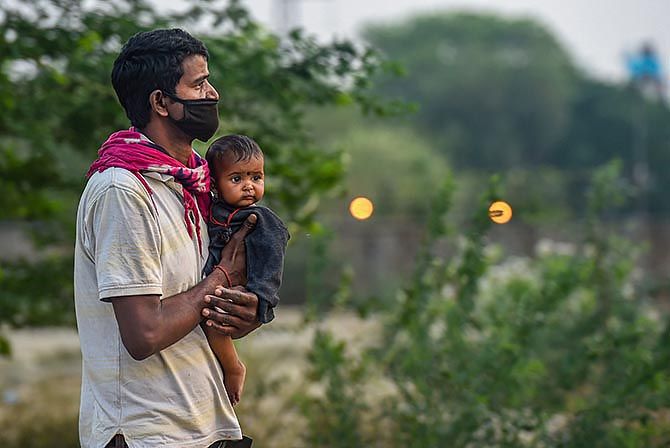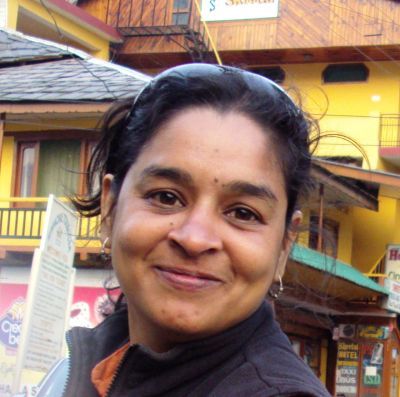 | « Back to article | Print this article |
'It may take two years for the economy to return to normal.'
'We should ensure that the vulnerable do not dig into their savings or give up their assets because that will set them back by several years.'

A country that produces surplus food is at the 97th position among 107 countries in the Global Hunger Index.
Some 14% of the population -- that is 189.2 million people -- of that country are under-nourished.
20% children under the age of five are under-weight.
34.7% of the children under the age of five are stunted.
51.4% of women in the age group of 15-49 are anaemic.
Also, 45-64% of the rural poor cannot afford a nutritious diet.
Yes, it is India that we are talking about.
Another startling report is that 50% of rural India is eating less due to the lockdown.
It is not that India cannot feed its entire 1.3 billion people.
So, why is it that India is behind countries like Pakistan, Bangladesh and Nepal in the Global Hunger Index?
Sudha Narayanan is an associate professor at the Indira Gandhi Institute of Development and an expert on agricultural economics.
"For those of us in the urban areas," Professor Narayanan tells Shobha Warrier/Rediff.com, "it is easy to look at the national figures and say that the hunger problem is solved. I don't think we have solved the hunger problem."
In the 2020 Global Hunger Index, India us placed at the 97th position among 107 nations. This is happening in a country that has surplus food stock.
It is reported that the food stock in September was 70 million tonnes, which can ensure food for every single citizen.
So why is India going hungry?
When you look at the national level statistics of the scale of production and the population per capita availability, it may be good. But the problem lies in distribution and accessibility.
To have access to food, you need a reliable market and where this is absent, a State supported food distribution system.
More than that, it must be affordable. In these parameters, India is not doing that well.
Leave ranking aside, just taking India in itself, we still have large pockets where hunger is still prevalent.
For those of us in the urban areas, it is easy to look at the national figures and say that the hunger problem is solved. I don'\;t think we have solved the hunger problem.
Even in those districts considered richer, there are segments of population that still have constraints.
The second point is, food security is not about rice and wheat alone. In terms of nutritional security, we are way behind.
It is said that 14% the population is undernourished which is a huge number in a country of 1.3 billion people.
Yes, the scale of the problem is large for a county as large as India. Other than the 14% of the population that is undernourished, a significantly larger population is anaemic.
Other micronutrient deficiencies are also very high.
For a majority of the population, nutritious diets are not affordable.
Recent work by the International Food Policy Research Institute suggests that as much 63%-76% of the rural population cannot afford a nutritious diet even if they spend their entire income on food.
So, the hunger problem is not just about access to cereals, but also about not getting a nutritious diet.
Do you feel the public distribution system that we have, is faulty?
PDS is a lifeline like for example, the MGNREGA. Where there are pockets of hunger and starvation, we have noticed that people rely overwhelmingly on PDS.
In some ways, there is a psychological sense of well-being and comfort when the public distribution system works.
There are, of course, a lot of problems in the design, and there is leakage too. But it has played a key role in ensuring food security to the vulnerable.
But there is still scope for improvement both in terms of quality of the grain that is distributed as well as in the prevention of leakages.
Is it not a shame that in a country that has a National Food Security Act and that produces surplus food, people are hungry?
Yes, it is a shame. Malnutrition and hunger are a national shame.
 The message has to go out that this has to be a national priority. Unfortunately, many feel it is not a problem to be solved.
The message has to go out that this has to be a national priority. Unfortunately, many feel it is not a problem to be solved.
In fact, you have people questioning malnutrition numbers saying the metric that is used is not correct and not appropriate for India, and that if you change the metric, we are doing fine.
What is needed is, first, you have to acknowledge that there is a problem. Then, prioritise the issue.
Unless these two are done, it is hard to address the issue.
If you look at countries with comparable economic growth rate, India' improvement in hunger and malnutrition is not that impressive.
But it is well-recognised that economic growth alone will not automatically solve the malnutrition problem. You have to tackle malnutrition as a separate issue. For that, you have to recognise the problem first.
Another aspect is, India faces a peculiar situation in which along with malnutrition, you also have growing obesity and overweight.
Is it a reflection of the social disparity in the country?
One part of it is economic disparity.
The other is that overweight and obesity are not purely rich people's problems. There are a lot of people from the poorer sections of society who depend on cheap and unhealthy food for their energy requirements.
This takes us back to the need for nutritious diet. You may get energy sources from something that is inexpensive which may not be healthy. So, you end up having overweight and obesity issues even among people who are poor.
It is a reflection of economic disparity as well as unaffordability of healthy diets. This is not an easy problem to solve, and you can't expect private markets to solve all these problems.
You need very thoughtful and appropriate policies from the state to enable people to have access to nutritious food.
Twenty years ago, when I interviewed Dr M S Swaminathan, he had said that India's problem was not food availability but accessibility. Even after two decades, we are still talking about lack of accessibility.
Absolutely. It shows that we have not acknowledged the problem and acted upon it.
Some people say urban poverty is worse than rural poverty. Do you think we can categorise poverty into urban and rural?
I think it is important to recognise the interlinkage between rural and urban because what happens in the rural areas will have an impact on the urban areas and vice versa. So, you can't separate it and say one problem is greater than the other.
For example, if you look at water availability, depletion of ground water is considered as a reason for migration to cities. That's because quality of life in the rural areas and the prospect of agriculture goes down with lack of water.
I think it is dangerous to segment poverty into a rural problem and an urban problem. Solutions may be different because urban areas have different characteristics compared too rural areas.
But it is important to look at this as a part of a whole rather than distinct problems. When you come out with solutions, it is important to understand the interconnections.
For example, when you have an MGNREGA programme in the rural areas, it reduces distress migration in the short term. In some way, it also reduces the urban hunger problem because seasonal migrants live in very poor conditions and are very vulnerable.
When you have a programme like MNREGA, they can stay back at home during the lean season, and work. So, it will have an impact on the hunger problem both in the rural areas and in the urban areas.
In that sense, the interconnection has to be recognised.
Do you feel with loss of jobs due to the pandemic, hunger is going to be a bigger problem in the coming months?
It is a concern. The question is, how resilient are the poor in a prolonged crisis. It is easier to tide over a short crisis. But when it prolongs, they will be forced to sell whatever assets they have to support themselves.
I don't think we are going to get out of the economic crisis very soon. I think it may take two years for us to return to the normal.
Assuming it is two years, we should see to it that the vulnerable will not dig into their savings or give up their assets because that will set them back by several years.
Until the economic crisis is over and jobs return, the focus should be on preventing the poor from falling behind.
So, the need for safety nets like PDS, cash transfers, MGNREGA etc have to be there for a couple of years with clear guidelines.
The government has to send signals that they are willing to support the programmes by putting in resources. That will give people confidence to build back their lives. That signal is very important now.